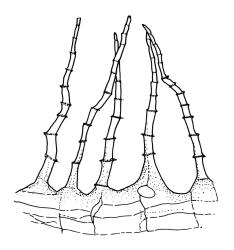Mittenia is a monotypic genus with the characteristics of M. plumula.
Mittenia is one of Australasia’s bryological curiosities, because of its aberrant peristome and the "luminescent" quality of its sometimes persistent protonema. Stone (1961) provided a fascinating explanation of cell form and arrangement of the protonema in Mittenia, and its resultant ability to refract ambient light; this ability sometimes gives the protonema a luminescent appearance. Stone referred to two phases in the protonemal development of Mittenia, with one being a "highly refractive stage with lens-like cells". The protonema have branches "composed of lenticular cells spread out in a plane at right angles to the light and sometimes appearing like plates of tissue". The lenticular shape of the cell walls concentrates incoming light on the chloroplasts, which are massed near the more highly convex underside of the cell. According to Stone the luminosity is a result of the light that is not absorbed by the chloroplasts being reflected, giving the protonema a "striking green lustre". The lustrous areas of the protonema are "regions of the lenticular protonema…[receiving]…incident light from a suitable direction".
Mittenia has often been compared in this regard to the famed Schistostega pennata, the "luminous moss" or "goblin gold" of the northern hemisphere. Plants of both these "luminescent" genera grow on soil in conditions of extremely low light.
| Category | Number |
|---|---|
| Indigenous (Non-endemic) | 1 |
| Total | 1 |




